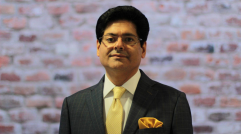Nail Salons Uninspected, Exposing Workers and Customers to Toxic Fumes
The ubiquitous and popular mani-pedi has salons competing for customers in over 2,000 licensed nail salons in New York City.
But many of the salons, according to a new report, are often uninspected, and often toxic for workers and customers.
And it is not just in New York -- stories of similar problems are surfacing in other cities.
Nail salons are a profitable $7 billion industry and a big employer of immigrant and undocumented women. A 2013 study by the U.S. Bureau of Labor Statistics found 13,100 nail salon technicians were working in New York alone. Nationwide, salons provided jobs to 87,000 employees, and the industry is expected to grow by 16 percent in 2022. Often the technicians' language proficiency is limited and they are not aware of potential health concerns.
"The problem is that there are 5,000 nail salons throughout New York ... but there are only 27 inspectors," said Public Advocate Letitia James who issued the report "How Safe is Your Nail Salon?"
The Department of State has a website, but the inspection of nail salons is not listed and that is part of the problem.
New York City is not responsible for inspecting salons for cleanliness and safety or granted authority -- that lies with the New York State Department of State.
"We really need more inspectors, to provide more information to the workers and customers, citywide and statewide. We are interested in the carrot approach as opposed to the stick approach. We are not interested in closing down businesses, but to empower the men and women that work at these salons. It is critically important that they know about the chemicals," James told reporters.
Questions are being raised about cleanliness but also about repeated exposure to three chemicals: toulene, formaldehyde and dibutyl phthalate, often known as the toxic trio -- and linked to reproductive and respiratory problems and cancer.
The Environmental Working group, which conducts research and advocacy on human and environmental health found the intensity of exposure for salon workers is 1,200 times what it would be for the average American.
In a survey of 100 nail salon workers in New York City conducted by NYCOSH and Empowering the Korean American Community, 37 percent of workers complained of skin problems, eye problems, 57 percent suffered from allergies and 66 percent from neck or back discomfort and 18 percent from asthma.
"In Boston, San Francisco in the Bay Area and Seattle, they have programs in place, and they have been going on for a couple of years already. But New York is such a large market and Boston with only 200 salons, whereas we are talking about 2,000 salons in New York City, so it is a challenge of a different scale as well," said Luna Ranjit, head of Adhikaar, a human rights and justice organization for Nepalese laborers.
The report comes with five recommendations: a Healthy Nail incentive program to provide businesses with a $500 grant to be used towards ventilation expenses; improving air quality; documenting health problems and use of personal protective equipment by salon workers; multilingual health and safety information; protective gear like gloves, goggles, and face masks: and city inspectors to supplement the state inspectors.
Subscribe to Latin Post!
Sign up for our free newsletter for the Latest coverage!
* This is a contributed article and this content does not necessarily represent the views of latinpost.com














